Can You Eat Clams Raw? Types, Health Benefits, Risks & Delicious Recipes. 🐚🦪

🐚 The Ultimate Guide to Clams
Types, Health Benefits, Risks & How to Eat Them Safely.
Clams are one of the ocean’s hidden treasures — tiny, briny morsels packed with flavor, nutrition, and culinary potential. Whether you enjoy them raw on the half-shell, tossed into pasta, or in a hearty chowder, clams are a versatile seafood delight.
But there’s more to clams than meets the eye. Not all clams are safe to eat raw, and each type has its own taste, texture, and best preparation method. At Pungu’s Kitchen, we love to explore every aspect of food — from nutrition to cooking tips — so you can enjoy seafood safely and deliciously.
In this guide, we’ll cover:
The most common types of clams
Their nutritional value and health benefits
Risks of eating raw clams and who should avoid them
Safe ways to prepare clams
Delicious serving ideas and chef tips
Let’s dive in!
🐚 Types of Clams – A Detailed Guide
Clams come in many shapes, sizes, and flavors. Some are ideal for raw consumption, while others are best enjoyed cooked. Here’s everything you need to know about the most popular types:
Littleneck Clams

Littlenecks are the smallest of hard-shell clams, usually 1–2 inches across. Their shells are smooth, firm, and tightly closed, often with subtle ridges and natural color patterns of beige, gray, or brown. The meat inside is tender, juicy, and slightly sweet, with a fresh ocean taste.
Habitat:
Found in sandy or muddy tidal flats along the Atlantic coast, particularly in New England.
Nutritional Notes:
High in protein (~12g per 100g), low in fat (~1g), rich in iron and vitamin B12.
Culinary Uses:
Raw: Excellent on the half-shell with lemon or mignonette sauce.
Cooked: Lightly steamed, added to pasta, chowders, or stir-fries.
Preparation Tips:
Scrub shells thoroughly.
Check that the clam closes when tapped; discard any that remain open.
Serve immediately if eating raw.
Fun Fact: Littlenecks are considered the most tender and sweet of all hard-shell clams, making them a favorite for raw bar enthusiasts.
Cherrystone Clams
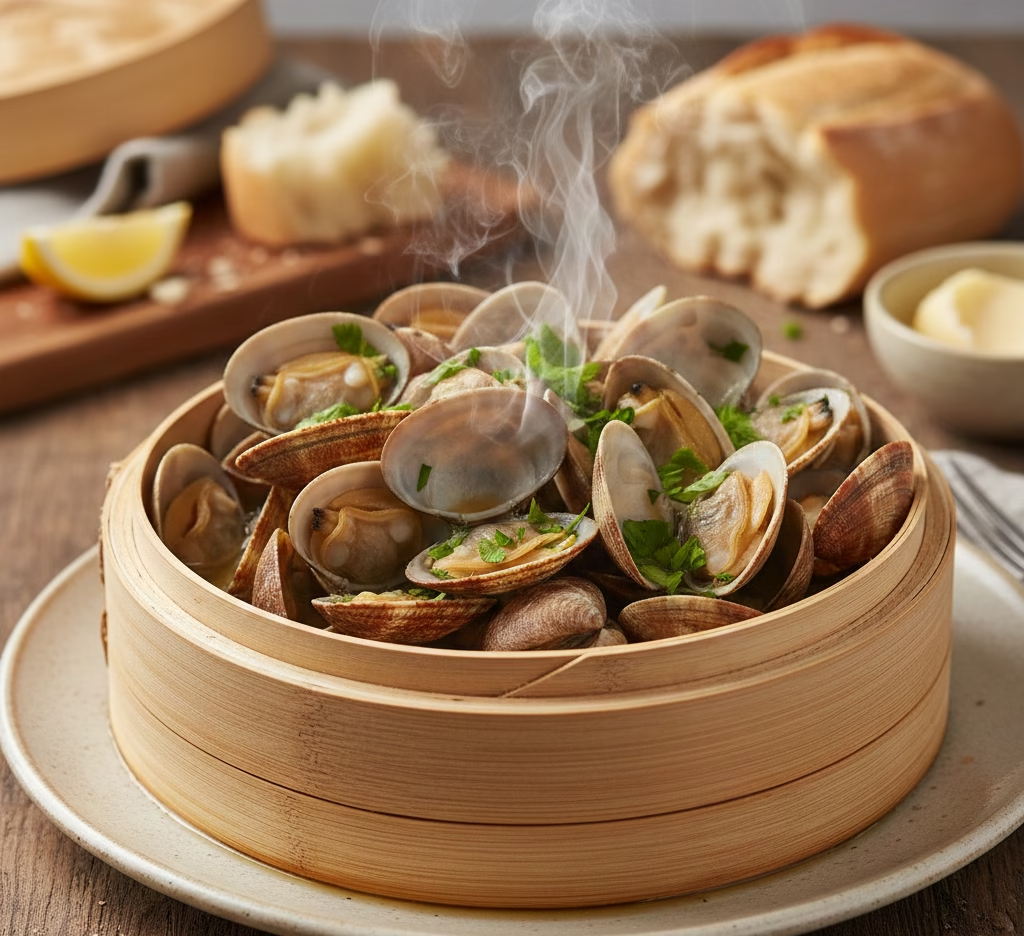
Cherrystone clams are larger than littlenecks, about 2–3 inches in diameter. Their shells are thick and sturdy, with a slightly rugged texture. The meat is firmer and slightly chewier than littlenecks, with a mild, slightly salty flavor.
Habitat:
Commonly harvested along the Atlantic coast of the US, thriving in sandy and muddy bays.
Nutritional Notes:
High in protein, iron, and vitamin B12. Slightly higher in calories than littlenecks due to larger size.
Culinary Uses:
Raw: Can be eaten on the half-shell if very fresh.
Cooked: Steamed, baked, or stuffed; popular in clam bakes and chowders.
Preparation Tips:
Soak in cold water for 20–30 minutes to remove sand before cooking.
Steam until shells open (usually 5–7 minutes).
Fun Fact: Cherrystones are often the choice for classic New England clam bakes because their firmer texture holds up well in long cooking.
Manila Clams
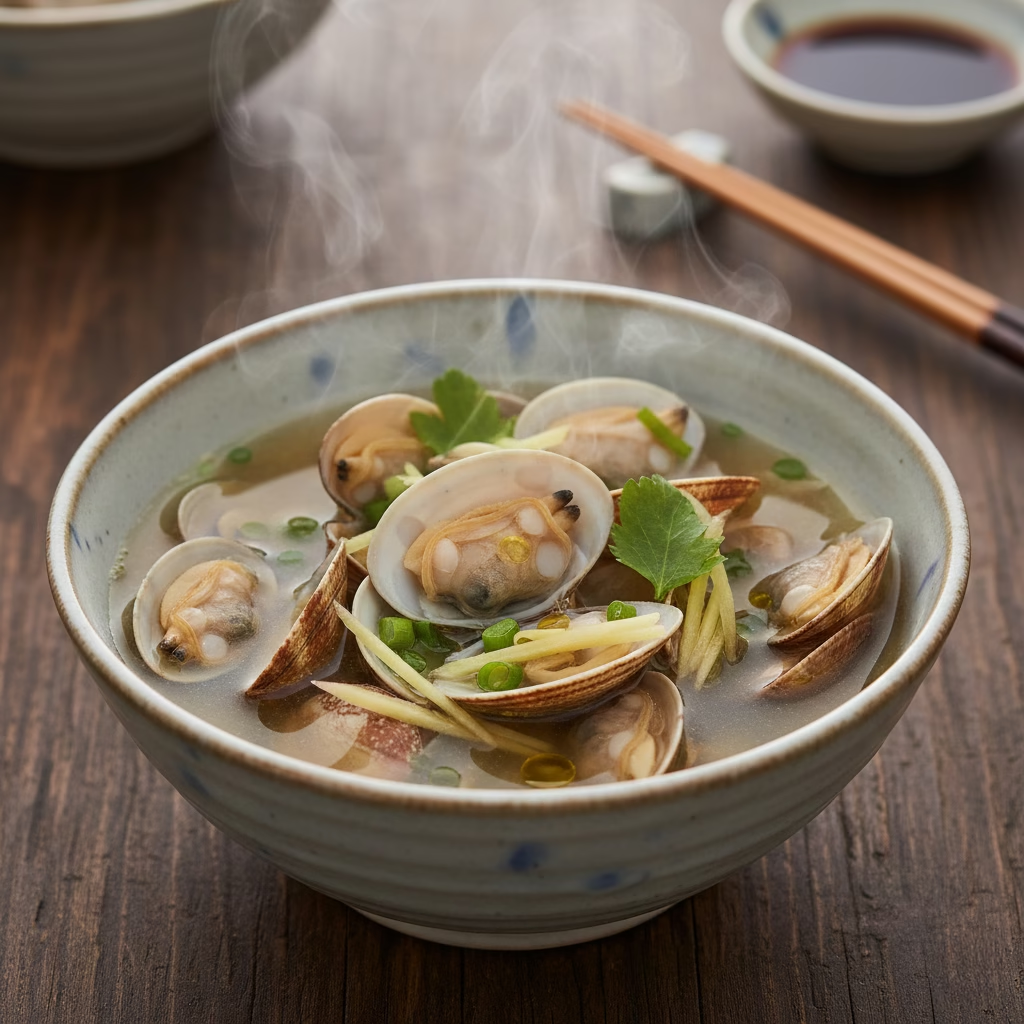
Small and oval-shaped, usually 1–2 inches, with colorful striations on the shell (brown, cream, or orange patterns). The meat is tender, sweet, and slightly nutty in flavor.
Habitat:
Native to Asia but widely farmed on both coasts of the US and Europe.
Found in sandy tidal areas and estuaries.
Nutritional Notes:
High in lean protein and vitamin B12, low fat, moderate sodium naturally from the sea.
Culinary Uses:
Raw: Sushi, sashimi, or ceviche when very fresh.
Cooked: Excellent in clear soups, seafood stews, pasta, and stir-fries.
Preparation Tips:
Rinse thoroughly to remove sand.
Check liveliness before consuming raw.
Steam or boil briefly to maintain tenderness.
Fun Fact: Manila clams are prized in Japanese cuisine for their delicate flavor and subtle sweetness.
Soft-Shell Clams (Steamers)
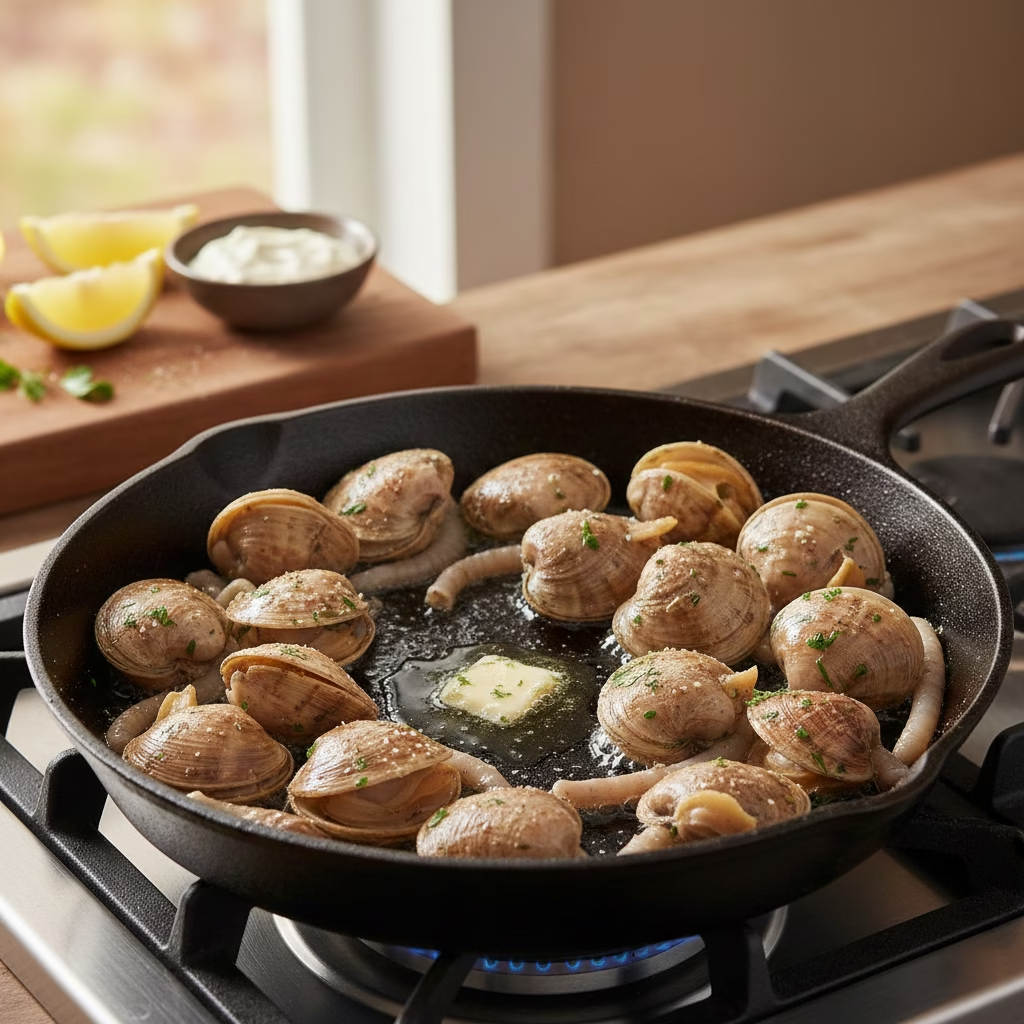
Longer, oval, soft shells that are slightly brittle. Meat is chewier and sweeter than hard-shell clams, with a pronounced ocean flavor. They often have a siphon (“neck”) extending from the shell.
Habitat:
Atlantic coast in sandy mudflats.
Nutritional Notes:
Rich in protein, low fat, a good source of iron and vitamin B12.
Culinary Uses:
Rarely eaten raw due to delicate shells.
Popular fried (New England-style clam strips), steamed, or in chowders.
Preparation Tips:
Scrub shells and soak in cold water to purge sand.
Steam or fry until cooked through.
Fun Fact: Soft-shell clams are often “raked” rather than dug, making them a specialty for coastal clam shacks.
Razor Clams
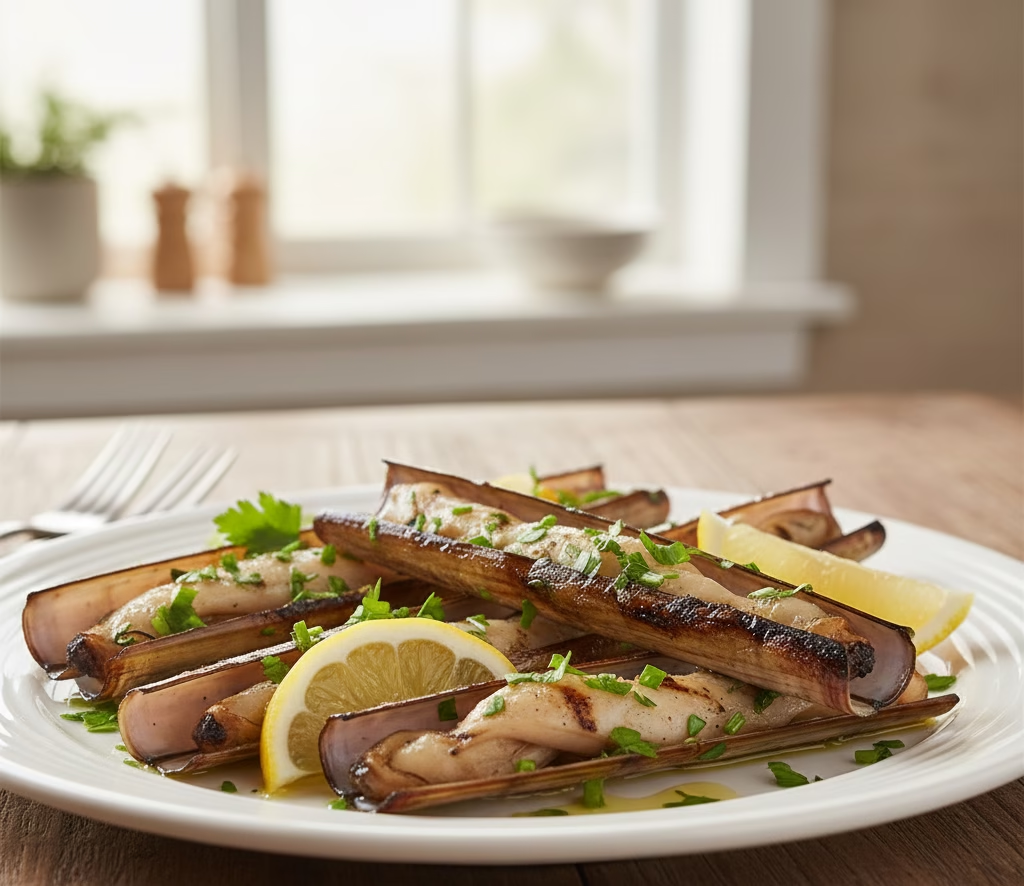
Long, narrow, tubular, resembling a straight razor. Shells are smooth and shiny, often brown or beige. Meat is tender, sweet, with a slightly chewy texture.
Habitat:
Sandy beaches and shallow waters of the Atlantic and Pacific coasts.
Nutritional Notes:
High in lean protein, low fat, contains vitamins B12 and D, iron, and selenium.
Culinary Uses:
Best cooked: grilled, stir-fried, steamed, or baked.
Excellent in Asian stir-fries or Mediterranean dishes with garlic and herbs.
Preparation Tips:
Clean thoroughly, remove sand from siphon.
Cook quickly to retain tenderness; overcooking makes them rubbery.
Fun Fact: Razor clams can dig into sand at remarkable speed, making them challenging to harvest.
Quahog / Chowder Clams
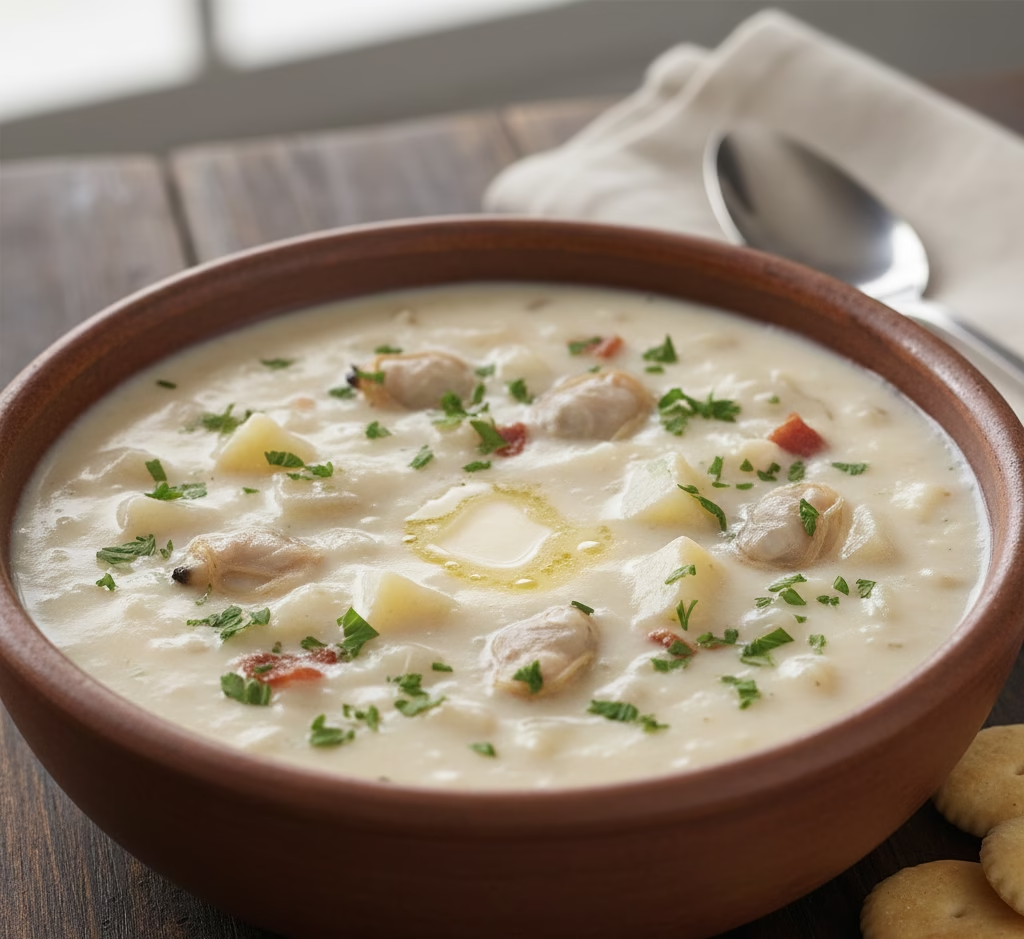
Large, hard-shelled clams with thick, dense meat. Chewy texture, robust briny flavor.
Habitat:
Eastern US coast, especially New England.
Nutritional Notes:
High protein, iron-rich, contains vitamin B12 and selenium.
Culinary Uses:
Not suitable raw.
Ideal for chowders, soups, and stuffing (e.g., New England clam chowder, clam cakes).
Preparation Tips:
Scrub shells, soak to remove sand.
Cook thoroughly in soups, stews, or baked dishes.
Fun Fact: Quahogs can live up to 40 years and are sometimes used in archaeology to study ancient diets.
🥗 Nutritional Value & Health Benefits of Clams
Clams are nutritional powerhouses:
High protein: Builds muscles and supports tissue repair.
Low fat: Heart-friendly and ideal for weight management.
Iron: Prevents anemia and improves energy levels.
Vitamin B12: Supports nerve and brain health.
Omega-3 fatty acids: Reduce inflammation and support heart health.
Selenium & Zinc: Boost immunity and antioxidant defenses.
Pungu’s Kitchen Tip: Light steaming preserves nutrients better than long cooking or frying.
⚠️ Risks of Eating Raw Clams
Raw clams can carry:
Vibrio bacteria – Can cause severe infections.
Norovirus or hepatitis A – Risk from contaminated waters.
Gastrointestinal illness – Nausea, vomiting, diarrhea.
Who Should Avoid Raw Clams:
Pregnant women, elderly, young children
People with liver disease, diabetes, or weak immunity
Anyone on acid-reducing medications
🔹 How to Eat Clams Safely
Buying & Storage: Licensed vendors, store <4°C.
Preparing Raw Clams: Scrub shells, check for liveliness, serve immediately.
Cooking: Steam, boil, grill, bake; avoid overcooking.
🍽 Delicious Ways to Serve Clams
Raw on the half-shell: Lemon or mignonette sauce
Clam chowder: Creamy, hearty soup
Garlic butter steamed clams: Simple, flavorful
Clam curry: Kerala-style with coconut and spices
Grilled razor clams: Smoky, tender, and aromatic
🌟 Pungu’s Kitchen Tips
Add colorful garnishes for visual appeal.
Light drizzles of olive oil, butter, or garlic enhance flavor.
Pair clams with fresh herbs and citrus for balance.
Clams are versatile, nutritious, and a true ocean delicacy. Raw clams are a treat for adventurous eaters, while cooking ensures safety and preserves flavor. At Pungu’s Kitchen, we encourage exploring both ways — just make sure you source wisely, store properly, and enjoy the full oceanic experience.
Disclaimer: The information in this article is for educational purposes only and is not a substitute for professional medical advice. Eating raw clams carries a risk of bacterial or viral infection. Always purchase clams from reputable sources, ensure freshness, and follow proper food safety practices. Individuals who are pregnant, elderly, have weakened immunity, or suffer from liver disease should avoid consuming raw shellfish. For personalized dietary guidance, please consult a registered dietitian or healthcare professional. Pungu’s Kitchen is not responsible for any illness or adverse effects resulting from the consumption of clams or other seafood.


You Might Also Like
Culinary Adventures: Exploring Taste & Tradition
Food has a unique ability to transcend boundaries, evoke memories, and bring...
Beyond Limits: The Inspiring Journey of Vipassana Asha — Cooking, Courage & Creativity.
Meet Vipassana By Asha, a blind motivational chef who turns challenges into...
Are Food Colors or Preservatives Actually Good for Your Health?
At Pungu’s Kitchen, we believe the best food comes from fresh, natural...
Nourish Your Body: Simple Tips and Recipes for Healthy Cooking
In today's fast-paced world, maintaining a healthy diet can often feel like...
How Long Can You Keep Cooked and Uncooked Meat and Fish in the Fridge?
Learn how to safely store raw and cooked meat and fish in...
Top 7 Health Benefits of Sprouted Moong Beans🌱
Sprouted moong beans are a superfood packed with protein, fiber, and essential...